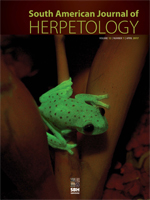Acoustic signals are the main communication mechanisms in anuran amphibians. Herein is described the vocal repertoire, call variation, and calling site of Boana jaguariaivensis from a population of the Tibagi, Paraná State, southern Brazil. Seventeen males were recorded in December 2012 and February 2013. Males of B. jaguariaivensis used shrubs, herbs and grass as calling sites, and the eggs were deposited on branches in the water body. The advertisement call was composed of 1–4 notes with harmonic structure. Call B was composed of a single, pulsed note with harmonic structure. The distress call was composed of a single, pulsed harmonic note. All spectral parameters had static properties, whereas all temporal parameters had dynamic properties. Also, all acoustic properties varied more between than within males. The variation observed in the acoustic parameters of B. jaguariaivensis advertisement calls was not influenced by body size or air temperature. Data on vocal repertoires and factors that can change acoustic parameters are important for progress in research on the taxonomy, phylogeny and evolution of anuran amphibians.
How to translate text using browser tools
1 April 2017
Vocalizations and Bioacoustic Analysis of Boana jaguariaivensis (Caramaschi, Cruz, and Segalla, 2010) (Anura: Hylidae)
Vinicius Guerra,
Rodrigo Lingnau,
Rogério Pereira Bastos
ACCESS THE FULL ARTICLE
Acoustic discrimination
Advertisement call
Boana polytaenia clade
Cerrado
coefficient of variation
Hypsiboas
southern Brazil





